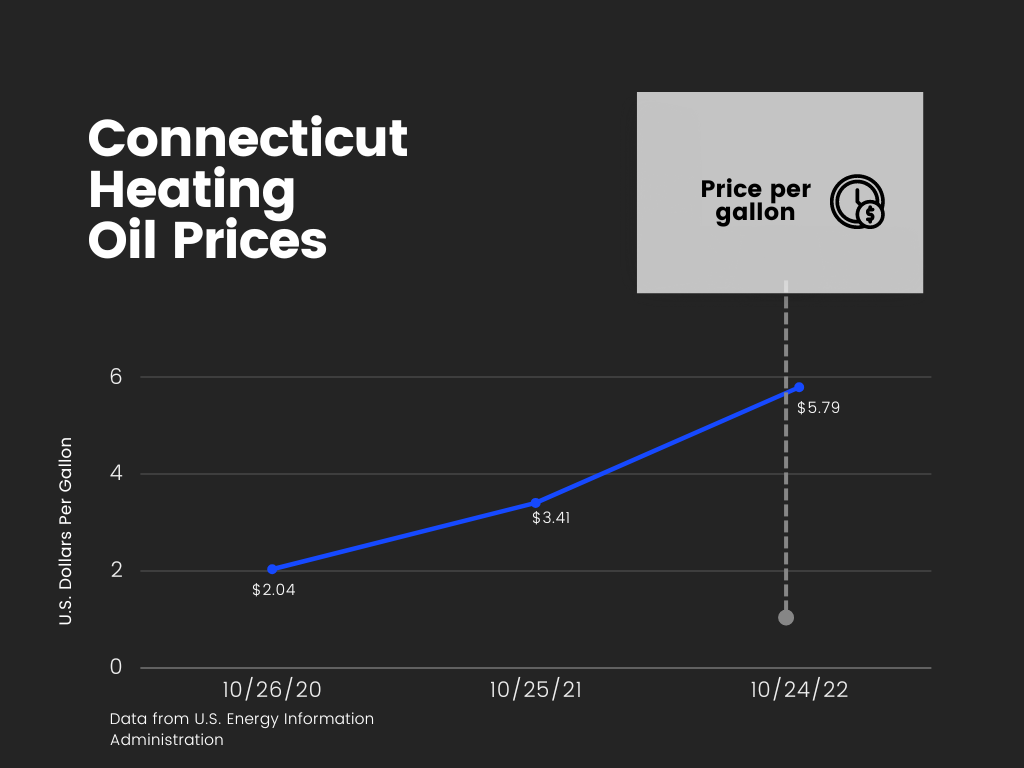Connecticut residents will be running to their thermostats and pulling out their checkbooks to purchase home heating oil as experts predict a sharp price rise in fuel this winter.
The Farmer’s Almanac, an unofficial, folksy weather predictor but one that people in New England swear by, predicts the coldest temperatures in Hamden, Connecticut, will be from mid-December to February 2023.
The more scientific long-range forecast from the National Weather Service’s Climate Prediction Center calls for a 40% chance of slightly warmer weather over normal this winter.
“November of 2022 through March of 2023, five months of our cold weather months, I think we are going to be normal to slightly below normal temperature,” said Brad Field, the retired chief meteorologist for NBC Connecticut.
“(In) New Haven, instead of getting about three feet of snow. I think you’ll probably get about 10 more inches,” said Fields.
Homeowners are predicted to pay 17.2% more to heat their homes for the winter, a report from The National Energy Assistance Directors’ Association indicates.
Shipley Energy, a home and business heating and cooling company in York, Pennsylvania, reports that the average size for an oil tank is 275 gallons and the heating oil could last for four months and two weeks, which covers most of the late-fall-to-early winter-spring season.
Hamden resident Michael Hanson, 28, noticed a shift in how much heating oil it takes to make his home warm in his 275-gallon tank.
“Last year, I could have put (the thermostat) on 60 (degrees), and sometimes it will be too hot,” Hanson said. “But, now I find that it’s on 70, so it’s like I’m burning more oil nowadays in my home.”
About 45% of Connecticut households use fuel oil or other petroleum product to stay warm in the winter, the Connecticut Department of Energy and Environmental Protection reports.
Hanson is a first-time homeowner residing in the Pine Rock neighborhood in Hamden. During the day, he works as a sales associate. He said the rising prices in the market are reducing his standard of living.
“I’m paying $340 a month for 10 months, so if you do the math that’s $3,400. When I think about it, it’s insane to pay that much,” Hanson said. “What I have to do is just keep in mind that I have to readjust my budgets; I got to spend money on things that I feel that’s important.”
Inflation rose to 9.1% this year in the U.S., a report by J.P Morgan said. There’s plenty of blame to go around for the soaring prices, from supply chain issues connected to the COVID-19 pandemic to the Russian invasion of Ukraine. What’s more, OPEC+ – the group of oil-exporting nations including Russia – decided in early October to cut production to increase prices that had been failing for months.
“For many people in New England and Connecticut, it is going to be difficult (in) decisions in terms of what they have to give up,” said David Cadden, an emeritus professor of business at Quinnipiac University.
“Now with global events, particularly the Russians in Ukraine, you’re seeing a tremendous spike in that natural gas. And on top of that, with Connecticut, we have no natural sources of natural gas; we have to pipe it all in.”
Before the Russian invasion of Ukraine on Feb. 24, heating oil prices moved lower, in part because the COVID-19 pandemic in 2020 triggered lockdowns that reduced fuel consumption as people stayed home. But when the pandemic eased in 2021, oil prices jumped, creating “price shocks” that led to inflation, a September 2022 study by the Federal Reserve Bank of Dallas revealed.
“Given the brakes that the (government) has put on the economy, I think it’s a race between what’s an acceptable level of inflation and the race to prevent a full-blown recession,” Cadden said.
The price of oil constantly fluctuates based on supply and demand.
When the price falls, more fuel is consumed leading to an increase in demand that, in turn, leads to price hikes.
Hanson noted he made a plan in the peak of the pandemic to put his stimulus checks aside and prepared for the market prices to rise.
“I’ve been planning ahead years before… there was a lot of cash I put it to the side, waiting on a time like this,” Hanson said.
Home heating oil stood at $2.04 per gallon on Oct. 26, 2020, according to the U.S. Energy Administration. Two years later, it had jumped to $5.79 per gallon as of Oct. 24, the government agency reported.

Consumers weigh choices in how they purchase heating oil. They could simply refill their empty tanks at the price that day or sign a contract that caps per-gallon prices for a year, providing some measure of economic certainty.
Hanson scoured the heat oil market to ensure he had the best strategy for purchasing.
“I was shopping around for oil prices and (companies) could set up a budget plan for you,” Hanson said. “I kept that in mind, for instance, there could be times going with another company, (and) there could be times where I can’t pay the money.
“I don’t know (whether) they’re going to charge me interest or stop delivery or leave me out to dry,” he said.
Bloomberg revealed New England companies may have to limit the amount of oil to consumers based on fuel availability.

Austyn Selmquist, vice president of operations at Hamden’s Pay-Less Oil, noted the increase in heating oil prices impacts the company as much as it does to the customers.
“As much as it’s high for the consumers, it’s high for us, too,” Selmquist said. “We are (the) type of company where we base our price off of what we’re paying for it and some other oil companies, you know, they offer like lock-in prices for the season.”
He added, “But that’s kind of like a gamble because you don’t know what can happen with the price.”
Selmquist noticed that consumers are buying less oil from the company.
“Filling your tank now if you have a normal-sized tank can cost like $1,000 if you’re empty,” Selmquist said. “We are seeing more people ordering less oil, rather than just filling up for the season, just because it’s so expensive.”
He recognized consumers’ concerns with affording home heating oil and recommended they budget as they prepare for the winter.
“Some people are used to filling up their tanks but they can’t because it’s just so much money,” Selmquist said. “It’s better to (purchase) now with the prices being so high, allocating certain funds for your fuel oil for heat.”
As heat oil prices rise, so do other home heating alternatives.
Hamden resident Harrison Lanes, 26, uses gas for heating living in a Hillside Village condominium with a roommate. His October gas bill increased $26 in a month, going from $32 in September to $58 in October.
Lanes predicts the price will rise in the winter months, he’ll use budgeting as his main strategy to pay the bills.
“I’d probably go out less, that’s probably like the number one thing I would do if I want to save money,” Lanes said. “It doesn’t sound all that bad, but I know that if like gas prices stayed at where they were for like another couple of months, then I probably have to really think about making some changes.”

The state and the town of Hamden have plans to help homeowners who can’t afford heating oil.
Connecticut residents can apply for the Connecticut Energy Assistance Program and may receive $250 to $600 toward their heating bill depending on income, household size and vulnerable members in the home.
Hamden also offers fuel and energy assistance to the town’s residents with certain restrictions, as well.

